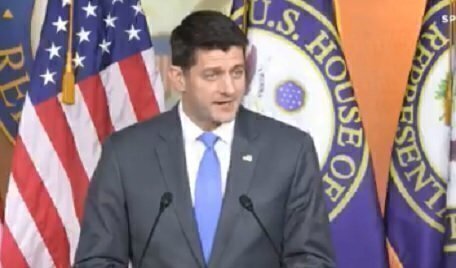Paul Ryan’s House retirement means that a new person will assume his role of Speaker of the House of Representatives next January and become one of the most important elected officials in Washington.
Ryan, 48, said on Wednesday  that he won’t seek re-election this November and will continue to serve as Speaker until a new Congress is seated in early January. Depending on the outcome of what is expected to be a close House election this November, one of the current party leaders in the House could assume Ryan’s critical role in that legislature. Currently, the two top Republicans under Ryan are Kevin McCarthy and Steve Scalise, while the two top Democrats are Nancy Pelosi and Steny Hoyer.
that he won’t seek re-election this November and will continue to serve as Speaker until a new Congress is seated in early January. Depending on the outcome of what is expected to be a close House election this November, one of the current party leaders in the House could assume Ryan’s critical role in that legislature. Currently, the two top Republicans under Ryan are Kevin McCarthy and Steve Scalise, while the two top Democrats are Nancy Pelosi and Steny Hoyer.
Today, the Speaker of the House serves in several major constitutional roles. The Speaker is the majority political party leader in the House, which on its own is one of the most powerful jobs in Washington. In addition, the Speaker controls the order of all institutional business on the House floor. The Speaker also votes on business as needed as a representative from a district.
In these positions, the Speaker plays a key role of negotiator between the House and President and with the Senate, and as the point person for the House’s fundamental role in originating and passing legislation, and controlling “the power of the purse” to tax and spend money.
The Speaker also is second-in-line to the Presidency under the Presidential Succession Act of 1947 after the Vice President, and the Speaker plays a role in the 25th Amendment’s process to deal with the event of a presidential disability.
Originally, the Constitution’s Article 1, Section 2 spelled out a very broad role for the Speaker: “The House of Representatives shall chuse their Speaker and other Officers; and shall have the sole Power of Impeachment.” The Founders’ intention appeared to be for the Speaker to serve as a parliamentarian and peace maker, more along the lines of the speaker in the British House of Commons. There wasn’t a detailed description of the Speaker’s role in The Federalist, the collection of essays written by Alexander Hamilton, James Madison, and John Jay. But the role changed as the political scope of Washington grew as the Founding era ended.
In 1811, Henry Clay became the first dynamic national political figure to assume the role of Speaker of the House. Since Clay’s three terms in the House, various Speakers have used different leadership styles in their critical jobs as national party spokesperson and House institutional leader. Since Clay’s time, the role of Speaker of the House has become more complex as the size of government has grown and federal budget spending is projected to pass $4 trillion in fiscal year 2018.
A list of the most prominent House Speakers since Clay includes Schuyler Colfax, James G. Blaine, Thomas Reed, Joseph Cannon, Champ Clark, Sam Rayburn, Joseph Martin, John McCormack, Tip O’Neill, and Newt Gingrich. And only one former House Speaker has been elected President: James Knox Polk.
The Speaker’s role within the House has also seen some important changes since 1789. Under the guidelines of Jefferson’s Manual, which serves as a foundation for the House’s rules, the Speaker originally didn’t talk on the House floor during debates and only spoke when conducting parliamentary manners. According to the Congressional Research Service, Clay was first Speaker to occasionally “speak” on the House floor during debates in the Committee of the Whole, but usually the Speaker only takes part in floor debates when there is a need to “to highlight or rally support for the majority party’s agenda,” says the CRS. Also, the Speaker didn’t get clear rights to vote of all House matters until 1850.
And there is one interesting, unique footnote about the Speaker of the House position: The job candidate doesn’t have to be a member of the House of Representatives. In the past 20 years, at least seven non-members of the House have received votes for the Speaker position during the floor voting process, including Colin Powell, Rand Paul, and Jeff Sessions. The Speaker is usually selected during party meetings before a new Congress meets, and the House confirms the selection by individual voice votes. There hasn’t been a Speaker election contested on the House floor since 1923.
Scott Bomboy is the editor in chief of the National Constitution Center.







